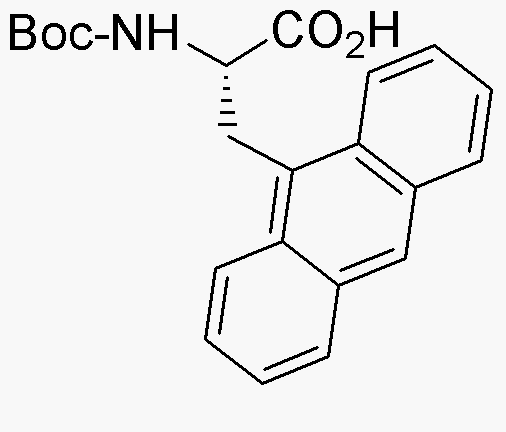Boc-3-(9-anthryl)-L-alanine is widely utilized in research focused on:
- Peptide Synthesis: This compound serves as a valuable building block in the synthesis of peptides, particularly in the development of novel therapeutic agents. Its unique structure allows for the introduction of aromatic properties, enhancing the stability and function of peptides.
- Fluorescent Probes: Due to its anthracene moiety, it is often used in creating fluorescent probes for biological imaging. These probes can help researchers visualize cellular processes in real-time, providing insights into cellular dynamics.
- Drug Development: The compound's ability to interact with biological targets makes it a candidate for drug development, particularly in oncology, where it can be used to design compounds that selectively target cancer cells.
- Material Science: In the field of material science, it is used to develop organic semiconductors. Its properties can be harnessed to create materials for electronic devices, such as organic light-emitting diodes (OLEDs).
- Bioconjugation: This chemical can be employed in bioconjugation processes, linking biomolecules to enhance their functionality. This is particularly useful in developing targeted drug delivery systems and diagnostic tools.
General Information
Properties
Safety and Regulations
Applications
Boc-3-(9-anthryl)-L-alanine is widely utilized in research focused on:
- Peptide Synthesis: This compound serves as a valuable building block in the synthesis of peptides, particularly in the development of novel therapeutic agents. Its unique structure allows for the introduction of aromatic properties, enhancing the stability and function of peptides.
- Fluorescent Probes: Due to its anthracene moiety, it is often used in creating fluorescent probes for biological imaging. These probes can help researchers visualize cellular processes in real-time, providing insights into cellular dynamics.
- Drug Development: The compound's ability to interact with biological targets makes it a candidate for drug development, particularly in oncology, where it can be used to design compounds that selectively target cancer cells.
- Material Science: In the field of material science, it is used to develop organic semiconductors. Its properties can be harnessed to create materials for electronic devices, such as organic light-emitting diodes (OLEDs).
- Bioconjugation: This chemical can be employed in bioconjugation processes, linking biomolecules to enhance their functionality. This is particularly useful in developing targeted drug delivery systems and diagnostic tools.
Documents
Safety Data Sheets (SDS)
The SDS provides comprehensive safety information on handling, storage, and disposal of the product.
Product Specification (PS)
The PS provides a comprehensive breakdown of the product’s properties, including chemical composition, physical state, purity, and storage requirements. It also details acceptable quality ranges and the product's intended applications.
Certificates of Analysis (COA)
Search for Certificates of Analysis (COA) by entering the products Lot Number. Lot and Batch Numbers can be found on a product’s label following the words ‘Lot’ or ‘Batch’.
*Catalog Number
*Lot Number
Certificates Of Origin (COO)
This COO confirms the country where the product was manufactured, and also details the materials and components used in it and whether it is derived from natural, synthetic, or other specific sources. This certificate may be required for customs, trade, and regulatory compliance.
*Catalog Number
*Lot Number
Safety Data Sheets (SDS)
The SDS provides comprehensive safety information on handling, storage, and disposal of the product.
DownloadProduct Specification (PS)
The PS provides a comprehensive breakdown of the product’s properties, including chemical composition, physical state, purity, and storage requirements. It also details acceptable quality ranges and the product's intended applications.
DownloadCertificates of Analysis (COA)
Search for Certificates of Analysis (COA) by entering the products Lot Number. Lot and Batch Numbers can be found on a product’s label following the words ‘Lot’ or ‘Batch’.
*Catalog Number
*Lot Number
Certificates Of Origin (COO)
This COO confirms the country where the product was manufactured, and also details the materials and components used in it and whether it is derived from natural, synthetic, or other specific sources. This certificate may be required for customs, trade, and regulatory compliance.


